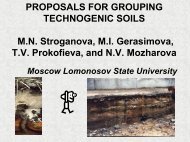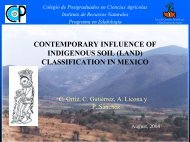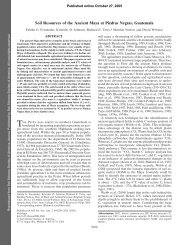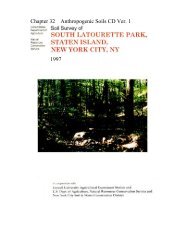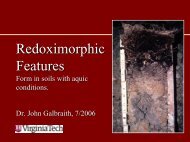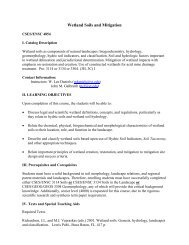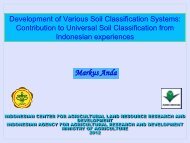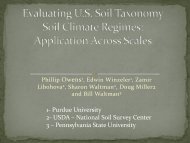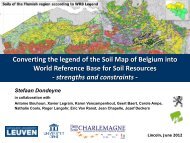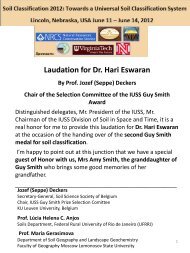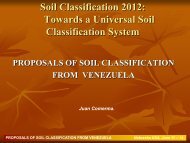Nebraska Soils Field Trip - Virginia Tech
Nebraska Soils Field Trip - Virginia Tech
Nebraska Soils Field Trip - Virginia Tech
You also want an ePaper? Increase the reach of your titles
YUMPU automatically turns print PDFs into web optimized ePapers that Google loves.
4th IUSS Soil Classification Conference <strong>Field</strong> Tour Guidebook<br />
Sand content--25 to 35 percent<br />
Rock fragment content--1 to 5 percent<br />
Calcium carbonate equivalent--10 to 15 percent<br />
Reaction--slightly alkaline or moderately alkaline<br />
Moist bulk density--1.8 to 1.9 g/cc<br />
COMPETING SERIES: This is the Storden series.<br />
Storden--have a clay content of 18 to 27 percent in the particle-size control section<br />
GEOGRAPHIC SETTING:<br />
Parent material--calcareous pre-Illinoian glacial till<br />
Landform--convex shoulder slopes on uplands<br />
Slopes--9 to 75 percent<br />
Elevation--305 to 457 meters (1,000 to 1,500 feet) above sea level<br />
Mean annual air temperature--8 to 11 degrees C (47 to 52 degrees F)<br />
Mean annual precipitation--66 to 81 centimeters (26 to 32 inches)<br />
Frost-free period--145 to 175 days<br />
GEOGRAPHICALLY ASSOCIATED SOILS: These are the Burchard, Deloit, Ida, Marshall,<br />
and Monona soils.<br />
Burchard--are in lower landscape positions on concave back slopes, do not have carbonates<br />
within a depth of 30 centimeters (12 inches), and have an argillic horizon<br />
Deloit--are in lower landscape positions on foot slopes and have mollic epipedons that are more<br />
than 61 centimeters (24 inches) thick<br />
Ida--are in landscape positions similar to those of the Liston soils, have a clay content of 18 to 25<br />
percent in the particle-size control section and have a sand content of less than 10 in the particlesize<br />
control section<br />
Marshall--are in higher landscape positions on summits, have a clay content of 30 to 35 percent<br />
in the particle-size control section, and have sand content of less than 10 percent in the particlesize<br />
control section<br />
Monona--are in higher landscape positions on summits, have a clay content of 20 to 30 percent<br />
in the particle-size control section, and have sand content of less than 10 percent in the particlesize<br />
control section<br />
DRAINAGE AND PERMEABILITY:<br />
Drainage class--well drained--a saturated zone does not occur within a depth of 183 centimeters<br />
(6 feet) during April to June in most years<br />
Permeability--moderately slow<br />
Surface runoff potential--medium to high<br />
USE AND VEGETATION:<br />
Most areas are pastured. A few areas are cultivated. Bluegrass is the principal pasture species.<br />
The native vegetation is big bluestem, little bluestem, indiangrass, switchgrass, sideoats grama<br />
and other grasses of the tall grass prairie and scattered oak trees.<br />
182



